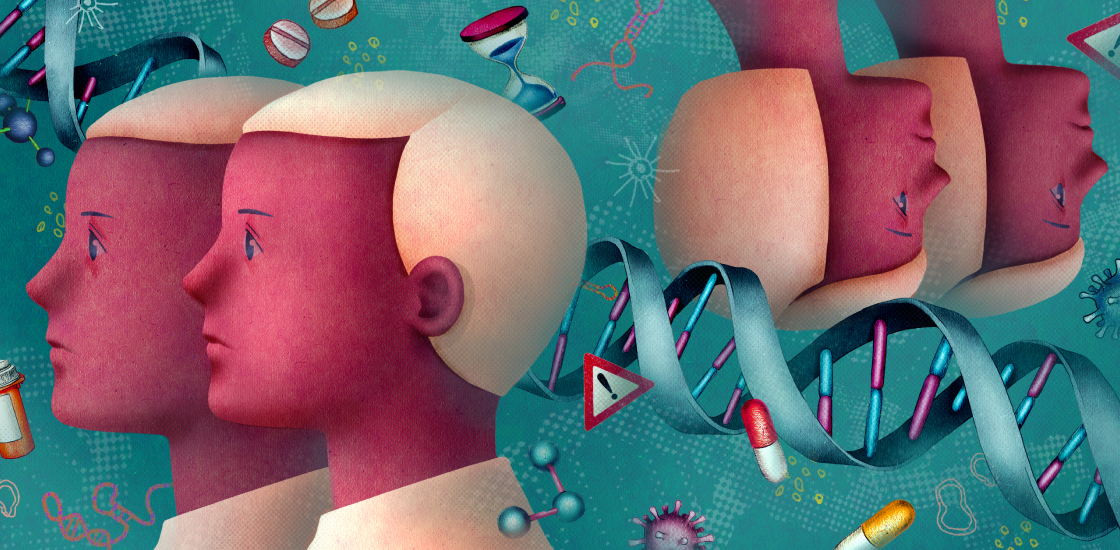THIS ARTICLE IS MORE THAN FIVE YEARS OLD
This article is more than five years old. Autism research — and science in general — is constantly evolving, so older articles may contain information or theories that have been reevaluated since their original publication date.

Scientists have for decades relied on studies of twins to parse the genetic versus environmental contributions to complex syndromes. Assessing the degree to which a condition affects both members of a set of identical twins, who share the same genetic information, can yield an estimate of the extent to which genetics underlie that condition.
Two new papers explore the genetic and environmental underpinnings of autism using data from the Twins Early Development Study, which follows identical and fraternal twins born in England and Wales in the mid-1990s.
In the first study, published 27 December in the Journal of Child Psychology and Psychiatry, researchers looked at autism traits in 6,413 twin pairs from the Twins Early Development Study and examined autism heritability in a meta-analysis of seven published twin studies, representing another 8,508 twin pairs. Their study suggests that genes trump environment in a big way: When one identical twin has autism, there’s a 98 percent chance that the other twin also has the condition1.
The second study, published 26 November in the Journal of the American Academy of Child & Adolescent Psychiatry, involved 207 identical and fraternal twin pairs, 127 of which include at least one twin with autism2. The researchers found that some autism-linked behaviors are more genetic in origin than others. Specifically, genes appear to largely dictate disruptive behaviors, such as rule-breaking and violent outbursts, whereas environmental factors underlie emotional symptoms such as anxiety.
Fruhling Rijsdijk, a statistical geneticist at King’s College London, was involved in both new studies. We asked her how studying twins can help settle the score between genetic and environmental factors in autism.
Spectrum: What can we learn from twin studies?
Fruhling Rijsdijk: Twin studies give us a handle on how individual differences in the population might be explained by genetic differences. It’s the first step that you would want to take before trying to identify specific genes involved in a certain trait or condition such as autism.
In addition to estimating the heritability of a single condition, these studies can help us understand why two conditions overlap. Quite often, conditions such as autism and anxiety co-occur, but we don’t really know why. Is it because of things that happened in the environment? Or is it something to do with shared genetic factors? That is very useful information that twin studies can provide.
S: What are the challenges of studying twins with autism?
FR: If you’re expecting to find high heritability in a trait such as [intelligence quotient], which is between 60 and 80 percent inheritable, then you would need a relatively small number of twins to detect such a strong effect. But when you don’t know what to expect, or when you expect the heritability to be low, you need to study a very large population.
In the case of autism, schizophrenia or other neuropsychiatric conditions, we can’t rely on large population databases of twins because the vast majority of those populations are unaffected. So we must go out and specifically look for affected twin pairs. All of the studies included in our meta-analysis, including our own study, specifically looked for affected twins.
S: Why do twin studies sometimes generate contradictory findings?
FR: Finding twins to include in the study is a problem. You need to do it as thoroughly as possible, and that’s why certain studies can be considered less reliable. Your study is only as good as the sample you get. If you don’t find many people, but the people you do find are representative of the autism community, then you’re fine. The problem comes when the people you find are not really representative of the autism population.
S: Can certain recruitment methods bias your sample?
FR: Two studies in our meta-analysis used a self-reporting database, which means that parents can just go onto the database and indicate that their son has autism, for example, and that he has a twin brother. We consider that biased data because, first of all, it’s difficult to gather whether these twins are really affected.
Also, are these people compelled to self-enroll in a database because they’re different in some way? One concern is that they might have more affected children in the family, and are therefore more likely to seek help or to want to self-enroll in databases. And if they have multiple affected family members, it could mean that they have a higher genetic risk in that family. So you’re potentially enriching your sample with people who show a higher genetic correlation, which could skew your findings.
S: What do you think is the best way to find affected twins?
FR: I would suggest that researchers, who are often clinicians as well, arrange with local hospitals to keep records of everyone who is a twin. In every hospital, when patients register for their appointments, the registration office should ask: Are you a twin? That simple question can give the best possible information on affected twin populations in a community and in the country as a whole. Or you can write to general practitioners; perhaps they know twins affected by a condition.
The best data we have are from Scandinavian countries that track medical information for the country’s whole population. When people register for benefits or medical help in those countries, their records are linked to hospital registers.
S: Your new study suggests that autism and certain psychiatric conditions, such as depression, share genetic roots, but that behavioral, or conduct, problems in autism stem largely from environmental factors. How did studying twins help you come to this conclusion?
FR: We’ve known for a while that children with autism have higher rates of emotional problems than exist in the general population. We also know that conduct problems in those children can be quite pronounced.
When emotional problems in twin 1 strongly predict autism in twin 2 and the other way around, there is a familial, and probably genetic, overlap in these traits. On the other hand, conduct problems in twin 1 do not predict autism in twin 2, and vice versa, but there is nonetheless a clear overlap between these traits in some individuals with autism. That relationship is most likely due to environmental factors.
S: What would you say to researchers who are skeptical of data from twin studies?
FR: There are still quite a lot of researchers who do not understand the method and say that twin studies are flawed. But it’s important to understand that all statistical methods have assumptions and limitations. And that’s a critical note to twins researchers as well: As long as you present the data in a fair way and aren’t over-interpreting your results, you’re fine. It’s important to keep a fair perspective on the limitations of the twins model.

By joining the discussion, you agree to our privacy policy.